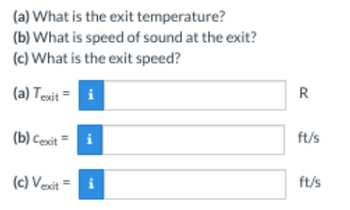An ideal gas is to flow isentropically from a large tank where the air is maintained at a tempera psia to standard atmospheric discharge conditions in a way to achieve a maximal velocity. Des duct involved and determine the duct exit Mach number and velocity in ft/s if the gas is air. The problem can be solved either using the isentropic relations or this figure. The isentropic r difficult to use unless you code them into a computer program. (a) What is the pressure ratio for the flow? (b) Is the exit flow subsonic, sonic, or supersonic?
An ideal gas is to flow isentropically from a large tank where the air is maintained at a tempera psia to standard atmospheric discharge conditions in a way to achieve a maximal velocity. Des duct involved and determine the duct exit Mach number and velocity in ft/s if the gas is air. The problem can be solved either using the isentropic relations or this figure. The isentropic r difficult to use unless you code them into a computer program. (a) What is the pressure ratio for the flow? (b) Is the exit flow subsonic, sonic, or supersonic?
Elements Of Electromagnetics
7th Edition
ISBN:9780190698614
Author:Sadiku, Matthew N. O.
Publisher:Sadiku, Matthew N. O.
ChapterMA: Math Assessment
Section: Chapter Questions
Problem 1.1MA
Related questions
Question

Transcribed Image Text:(a) What is the exit temperature?
(b) What is speed of sound at the exit?
(c) What is the exit speed?
(a) Texit =
(b) Cexiti
(c) Vexit i
R
ft/s
ft/s

Transcribed Image Text:An ideal gas is to flow isentropically from a large tank where the air is maintained at a temperature and pressure of 59 °F and 76
psia to standard atmospheric discharge conditions in a way to achieve a maximal velocity. Describe in general terms the kind of
duct involved and determine the duct exit Mach number and velocity in ft/s if the gas is air.
The problem can be solved either using the isentropic relations or this figure. The isentropic relations are more accurate, but
difficult to use unless you code them into a computer program.
(a) What is the pressure ratio for the flow?
(b) Is the exit flow subsonic, sonic, or supersonic?
(c) What is the exit Mach number?
(a) Pexit/Po= i
(b)
(c) Mexit =
Expert Solution
This question has been solved!
Explore an expertly crafted, step-by-step solution for a thorough understanding of key concepts.
Step by step
Solved in 4 steps with 5 images

Follow-up Questions
Read through expert solutions to related follow-up questions below.
Follow-up Question

Transcribed Image Text:(a) What is the exit temperature?
(b) What is speed of sound at the exit?
(c) What is the exit speed?
(a) Texit = i
(b) Cexit =
(c) Vexit =
i
i
R
ft/s
ft/s
Solution
Knowledge Booster
Learn more about
Need a deep-dive on the concept behind this application? Look no further. Learn more about this topic, mechanical-engineering and related others by exploring similar questions and additional content below.Recommended textbooks for you

Elements Of Electromagnetics
Mechanical Engineering
ISBN:
9780190698614
Author:
Sadiku, Matthew N. O.
Publisher:
Oxford University Press

Mechanics of Materials (10th Edition)
Mechanical Engineering
ISBN:
9780134319650
Author:
Russell C. Hibbeler
Publisher:
PEARSON

Thermodynamics: An Engineering Approach
Mechanical Engineering
ISBN:
9781259822674
Author:
Yunus A. Cengel Dr., Michael A. Boles
Publisher:
McGraw-Hill Education

Elements Of Electromagnetics
Mechanical Engineering
ISBN:
9780190698614
Author:
Sadiku, Matthew N. O.
Publisher:
Oxford University Press

Mechanics of Materials (10th Edition)
Mechanical Engineering
ISBN:
9780134319650
Author:
Russell C. Hibbeler
Publisher:
PEARSON

Thermodynamics: An Engineering Approach
Mechanical Engineering
ISBN:
9781259822674
Author:
Yunus A. Cengel Dr., Michael A. Boles
Publisher:
McGraw-Hill Education

Control Systems Engineering
Mechanical Engineering
ISBN:
9781118170519
Author:
Norman S. Nise
Publisher:
WILEY

Mechanics of Materials (MindTap Course List)
Mechanical Engineering
ISBN:
9781337093347
Author:
Barry J. Goodno, James M. Gere
Publisher:
Cengage Learning

Engineering Mechanics: Statics
Mechanical Engineering
ISBN:
9781118807330
Author:
James L. Meriam, L. G. Kraige, J. N. Bolton
Publisher:
WILEY